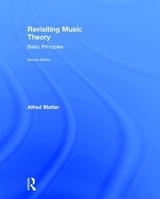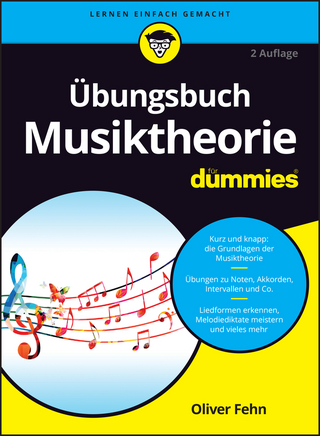
Revisiting Music Theory
A Guide to the Practice
Seiten
2007
Routledge (Verlag)
978-0-415-97439-4 (ISBN)
Routledge (Verlag)
978-0-415-97439-4 (ISBN)
- Titel erscheint in neuer Auflage
- Artikel merken
Zu diesem Artikel existiert eine Nachauflage
Teaches the basics of music theory as well as the vocabulary to use in harmonic and formal analysis. This book includes materials of music from J S Bach to John Cage. It shows how theory is applied to practice. It covers topics such as music notation, modes and scales, scale degrees, melodic form, vocal ranges, transposition, and others.
Revisiting Music Theory: A Guide to the Practice contains the basics of music theory with the vocabulary used in harmonic and formal analysis. The book assumes few music reading skills, and progresses to include the basic materials of music from J. S. Bach to the twentieth century. Based on Blatter’s own three decades of teaching music theory, this book is aimed at a one or two year introductory course in music theory, can serve for individual study, or as a review for graduate students returning to school. Drawing examples from well-known classical works, as well as folk and popular music, the book shows how theory is applied to practice.
The book is divided into five parts. The first part introduces music notation, reviewing the basics of pitch, time, and dynamics as represented in written music. Part 2 introduces the concept of melody, covering modes, scales, scale degrees, and melodic form. Part 3 introduces harmony, dealing with harmonic progression, rhythm, and chord types. Part 4 addresses part writing and harmonic analysis. Finally, Part 5 addresses musical form, and how form is used to structure a composition.
Revisiting Music Theory will be a valuable textbook for students, professors, and professionals.
Revisiting Music Theory: A Guide to the Practice contains the basics of music theory with the vocabulary used in harmonic and formal analysis. The book assumes few music reading skills, and progresses to include the basic materials of music from J. S. Bach to the twentieth century. Based on Blatter’s own three decades of teaching music theory, this book is aimed at a one or two year introductory course in music theory, can serve for individual study, or as a review for graduate students returning to school. Drawing examples from well-known classical works, as well as folk and popular music, the book shows how theory is applied to practice.
The book is divided into five parts. The first part introduces music notation, reviewing the basics of pitch, time, and dynamics as represented in written music. Part 2 introduces the concept of melody, covering modes, scales, scale degrees, and melodic form. Part 3 introduces harmony, dealing with harmonic progression, rhythm, and chord types. Part 4 addresses part writing and harmonic analysis. Finally, Part 5 addresses musical form, and how form is used to structure a composition.
Revisiting Music Theory will be a valuable textbook for students, professors, and professionals.
Alfred Blatter is on the faculty of The Curtis Institute of Music. A professor emeritus and former head of the Department of Performing Arts at Drexel University, he is a composer, hornist, and conductor. His compositions are published by Tromba Press, BIM, and Media Press. Schirmer published his book, Instrumentation and Orchestration (2/e), in 1997.
Preface Acknowledgements Notes on the Use of this Book part 1: Notation: The Symbols of Music part 2: Melody : Note Following Note part 3: Harmony: Note(s) with Note(s) part 4: Melodies in Harmony part 5: Musical Structures part 6: Appendices Endnotes Index
| Erscheint lt. Verlag | 24.5.2007 |
|---|---|
| Zusatzinfo | 300 Line drawings, black and white |
| Verlagsort | London |
| Sprache | englisch |
| Maße | 216 x 279 mm |
| Gewicht | 907 g |
| Themenwelt | Kunst / Musik / Theater ► Musik |
| ISBN-10 | 0-415-97439-9 / 0415974399 |
| ISBN-13 | 978-0-415-97439-4 / 9780415974394 |
| Zustand | Neuware |
| Informationen gemäß Produktsicherheitsverordnung (GPSR) | |
| Haben Sie eine Frage zum Produkt? |
Mehr entdecken
aus dem Bereich
aus dem Bereich



